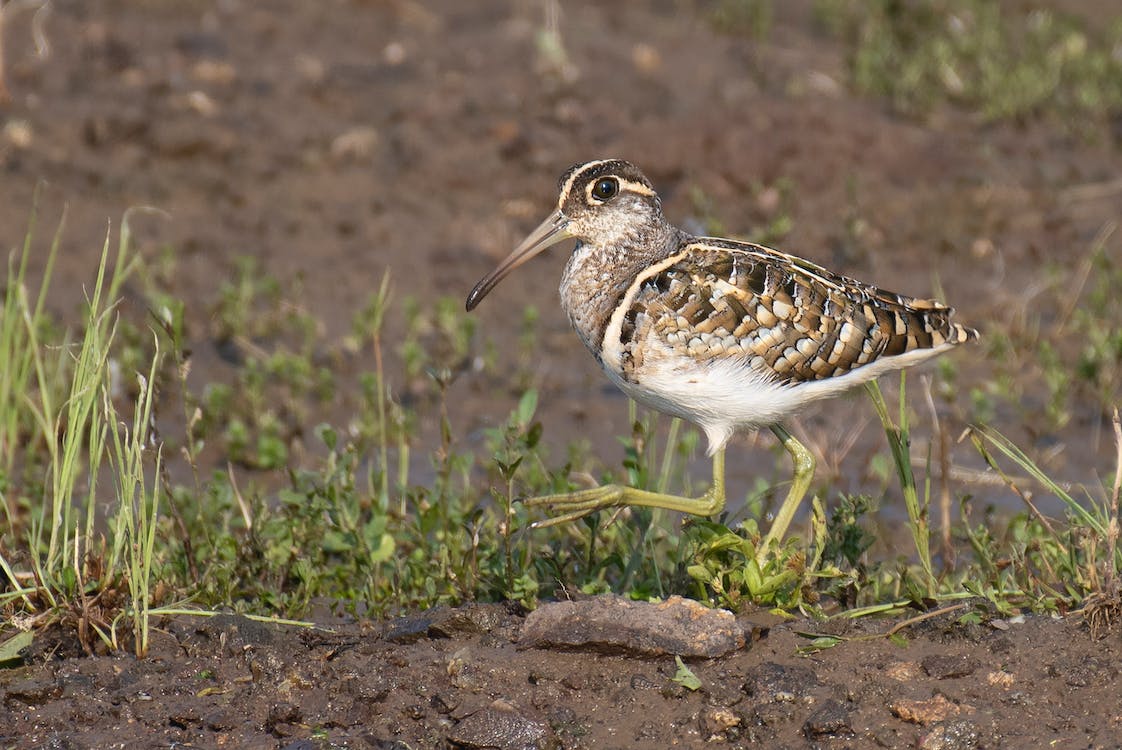It is a medium-sized, striking shorebird that thrives in marshes and grassy fields. Both males and females sport a distinct comma-like mark across the eye. Strong sexual dimorphism is observed on these birds and their roles interchange during the breeding season.
Read further to know more about the Greater Painted Snipe.
What is a Greater Painted Snipe?
Greater Painted Snipe (Rostratula benghalensis) is a wading bird belonging to the Rostratulidae family. It has a vast range and can be found in marshes in South Asia, Southeast Asia, and Africa. Their role reverses with the females doing the courtship displays, while males are in charge of the incubation and in raising the chicks.
Its seven levels of classification are as follows:
Kingdom: Animalia
Phylum: Chordata
Class: Aves
Order: Charadriiformes
Family: Rostratulidae
Genus: Rostratula
Species: R. benghalensis
Greater Painted Snipe Physical Description
Greater Painted Snipes are medium-sized, stabby, wading birds, growing from 9 to 11 inches or 23 to 28 centimeters, weighing around 90 to 200 grams, with a wingspan of approximately 19.6 to 21.6 inches or 50 to 55 centimeters.
These birds have a long, slender, rufous bill, which is slightly decurved at its tips, and a unique comma-like patch across the eye. The tail is short while wings are rounded and buff-barred. Meanwhile, the breast is white, which stretches around and above the folded wings.
Greater Painted Snipes have strong sexual dimorphism. Females are relatively larger and more vividly-colored than males. Neck, throat, and sides of the head have a bold chestnut-brown tone, while a sharp black band occurs across the breast. On the other hand, males have a duller and grayer plumage. Immature birds are similar to the males, sans the broken black stripe on the breast.
Where can they be spotted?
Greater Painted Snipes occur in South Asia, Southeast Asia, and African. The bird species thrive in tropical and subtropical wetlands, swamps, rice fields, mudflats, freshwater lakes, reedbeds, dams, pans, or any waterside habitat, present with mud and emergent vegetation.
Interesting Facts You Should Know About the Greater Painted Snipe
Greater Painted Snipes is an omnivorous wading bird that feeds on snails, crustaceans, insects, and earthworms. Other food items it may occasionally consume include plant matter, such as millet, rice, and seeds. These birds forage soft soil using the long, slender bill or disturb the water by moving the head and bill sideways or in a semi-circular motion. They are typically active during twilight, but may also probe for food singly or in small groups at night.
These birds have a polyandrous mating system, only becoming monogamous should their population density is low. A female greater painted snipe may have 2 to 4 mates each year. After laying the eggs, she will leave, passing the incubation, nesting, and caring duties to the male as she mates with another individual.
The female also does the courting, using a “spread-wing display.” Before she does so, she first preens its future mate then circle him, accompanied by soft calls. The actual display is characterized by both wings being extended, slightly swept forward, while the tail is raised and fanned. She then lowers her body and bill to the male. Once the coupling begins, the pair stands close to each other while uttering calls, with the female occasionally open and raising its wings upward.
The breeding season varies greatly depending on the range but is generally associated with rainfall. The nest is built on the ground, hidden in dense vegetation. It can also be placed on floating vegetation, forming a shallow cup made of plant materials, such as stems and leaves.
The female greater painted snipe will lay 2 to 5 eggs, which the male will solely incubate for around 18-19 days. Chicks are hatched precocial, which means they can feed themselves almost immediately. Broods will remain under paternal care for a few days and will soon become independent.
Greater Painted Snipes may be common, to uncommon depending on the range. While some declines are recorded due to habitat loss, they are still classified as Least Concern (LC) under the IUCN Red List of Threatened Species.
WILDLIFE PARKS AND RESERVES WHERE THIS SPECIES IS FOUND:
BOTSWANA
SOUTH AFRICA
Kalahari Gemsbok National Park
NAMIBIA
ZAMBIA
ZIMBABWE
BOTSWANA BIRDS | SOUTH AFRICA BIRDS
NAMIBIA BIRDS | ZAMBIA BIRDS | ZIMBABWE BIRDS
